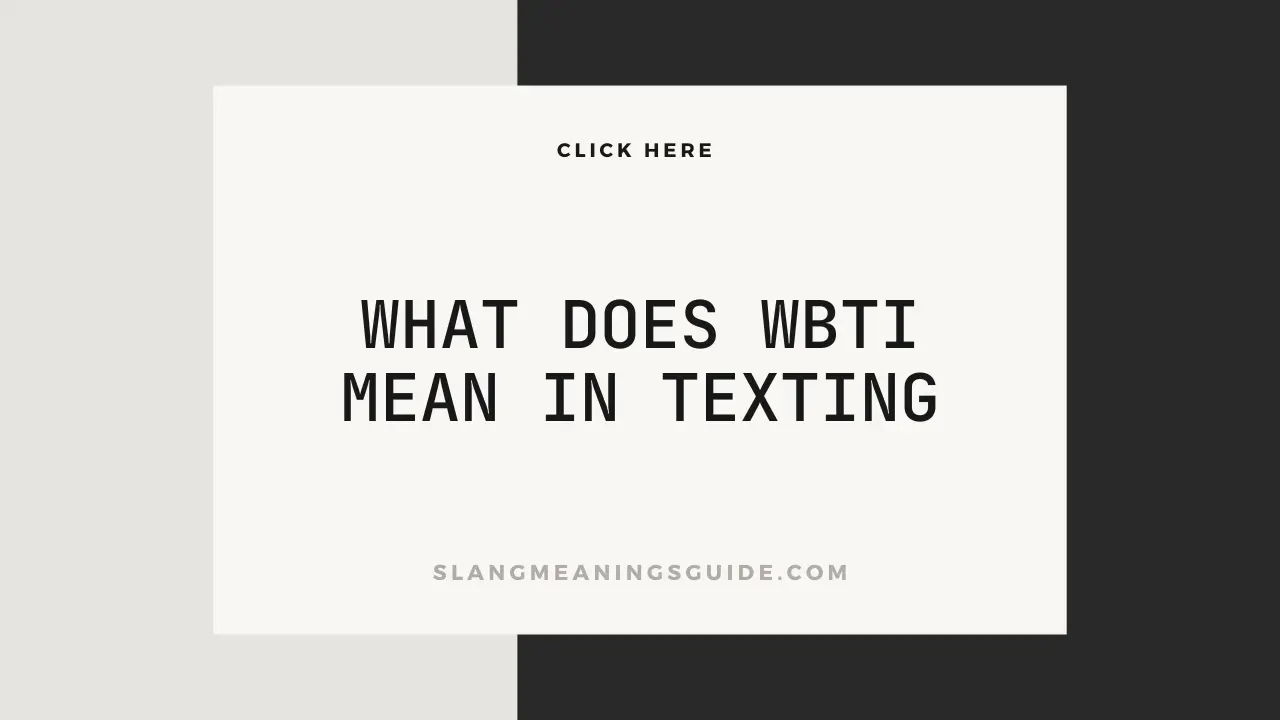WBTI is a new shorthand, abbreviations, and acronyms that have become invaluable for efficient and quick expression.
Yet, WBTI appears to be a less frequent variation or perhaps a typo. As such, a direct, well-known linguistic detail for WBTI in textual slang language doesn’t exist.
However, here is a piece that unpacks the meaning (and origin) of WBTI, why it’s sometimes confused for related abbreviations, and how it shaped language.
Origin of WBTI
While WBTI is not a widespread abbreviation, it has come to signify the fluid nature of texting slang and how new words can arise through neologism or typo and maybe flourish in their little communities or chat sessions.
Although ‘WBTI’ didn’t exist directly in any of the sources consulted, it could be an alteration or typo of ‘WTBI (which is a Radio Station)’ or some other slang that’s vernacular in some group or area.
If anything characterizes text ‘slang’, it is Changeability: any word or even emoji could suddenly appear and then change in form and use, often in response to a particular cultural phenomenon, a meme, or a community of speakers online.
What Does WBTI in Texting
- Will Be There In
Sometimes, WBTI is used to let the other person know when you’re going to arrive. It is typically used in informal texting (e.g., Whatsapp), social media, or messaging.
Examples:
“WBTI 10 minutes”
“WBTI an hour”
2. Would Be True If
It is a conditional utterance used to express a hypothetical condition: if that, then I would/do that. Developed in English-speaking cultures. (Other languages might not operationalize this variant for tense that much)
Examples:
“WBTI I had more free time, I would travel more.”
“WBTI, I won the lottery; I would buy a house on the beach.”
3. Who’s Been Taking It
WBTI is also used as an ironic or playful way of texting to ask who has been taking X, whether it’s a joke or a meme. This meaning is mostly for playful, informal contexts. It’s more relevant to the identity of young people. At least, it’s relevant as it exists online. It might not exist the same way offline or in the future. It might very well not exist at all in other languages.
Examples:
“WBTI, all the snacks?
“WBTI all the good Netflix shows?”
4. Workplace Bullying & Trauma Institute
It is the acronym of a group or an initiative on workplace bullying and trauma. In this example, it stands for the following option: a) an organization or team working with the issues of workplace bullying and trauma for organizations or employees who have had a victimization experience at work.
Example:
“Our company is partnering with WBTI to create a safer work environment.”
5. World Breastfeeding Trends Initiative
This acronym refers to a worldwide initiative to promote and support breastfeeding. In the below given example, WBTI represents a joint initiative to advance breastfeeding and interventions to improve related health policies and practices.
Example:
“The WBTI report highlights the importance of breastfeeding for maternal and child health.”
Other Variation and Related Terms
The acronym WBTI is mostly used to say at what time a person plans to reach a place, or when a task will be finished. Here are five related terms and variations, with the explanation and example:
1. ETA (Estimated Time of Arrival): This term is very frequently used to refer to the time a particular person is anticipated to arrive at some place or another. WBTI is more formal than ETA and is often used in more professional contexts.
Example: “My ETA to the party is around 8 p.m. See you then!”
2. OMW [or On My Way]: used to let someone know you’ve started on the way to a place. It indicates motion and progress toward an end but does not specify a timeframe; it means ‘on my way’.
Example: “Just finished packing up. OMW to your place now!”
3. BRB (Be Right Back): Used to convey the intention to depart from an ongoing conversation or activity briefly, BRB suggests the individual will return shortly. While it doesn’t directly refer to reaching a destination, it’s thought of as a destination.
Example: “Need to grab a snack. BRB in 5 minutes.”
4. EOD (End Of Day): EOD, often used in professional correspondence, means the end of a working day. It implies that tasks would be done or arrivals made by the end of business hours. They are not due at a specific time, such as 2 p.m. WBTI. Because it’s less specific, it places more emphasis on punctuality.
Example: “I’ll have those reports to you by EOD.”
5. Ttyl (talk to you later) gives no info about arrival or completion times. But, it relates to ‘L8r’ as it signals a pause or deferment in conversation. It implies that the conversation will resume later.
Example: “Running late for my meeting, TTYL!”Note: Each of these is a placeholder for a different level of detail about the timing (and potentially availability) of an invitation.

